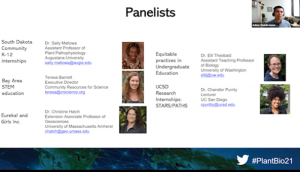By Sibongile Mafu (WiPB) and Adam Steinbrenner (EDIC)
The Equity Diversity and Inclusion Committee (EDIC) and Women in Plant Biology (WIPB) co-hosted a workshop at the Plant Biology 2021 Annual meeting entitled “Sustained Commitments to Diversity and Inclusion”. The invited panelists have focused their careers on outreach and teaching at critical early stages in student training, especially development of STEM identity and self-efficacy at an early age. A recording of the panel is still available for viewing for Plant Biology 2021 attendees through the conference portal https://www.eventscribe.net/2021/ASPB/.
Exposure to science concepts at an early age is essential to build the scientific identity. Bringing early career scientists to the K-12 education process is important for teaching the process of inquiry, but also to ensure students have access to role models, especially persons that look like them. One of the major challenges or recurring themes is that the diversity in the population of students is not representative of the diversity in the community.

Three speakers highlighted their roles in established, large-scale K-12 education programs. Prof. Sally Mallowa at Augustana University in Sioux Falls SD coordinates a program to engage Indigenous (Native) Americans and students from the refugee community, as well as an international program based in Kenya where she travels most summers. Prof. Christine Hatch works with the Eureka program, an initiative between Girls Inc and UMass-Amherst that focuses on economically marginalized and URM students in Springfield MA. Teresa Barnett is the Executive Director of Community Resources for Science, a substantial operation based in California that leads classroom visits and outreach programs at the K-8 stage. In addition to the children, CRS also provides training opportunities for the STEM researchers to work with teachers’ needs and to develop communication and engagement skills. The programs ensure visibility in media outlets to link volunteer efforts with their campus community.
Engagement efforts at the K-12 level have been instrumental in increasing participation and interest through to the undergraduate level. However, there is a massive loss of students in the pipeline during undergraduate and graduate training, where the tone of classes and research is often exclusionary and lacking retention and support structures. Dr. Chandler Purity, a Lecturer at University of California, San Diego, highlighted that we should not be inviting our students into a “burning building” in graduate training. She drew on experiences of her and her graduate cohort to describe how scientific training often shames rather than nurtures. Mental health challenges and abuse are rife. The development of STEM identity and self-efficacy must combine with building inclusive environments around STEM education and training. Ensuring support for cultural adjustment is as critical a component as recruitment.
Teaching practices focused on equity and inclusion go a long way in ensuring retention. Elli Theobald, a Biology Lecturer at the University of Washington, highlighted the value of active learning. High intensity active learning achieves greater equity than lectures; this reduces the achievement gaps especially from persons excluded due to ethnicity or race. In addition, students want to understand how what they are learning will be applicable and solution based so as to have a direct and immediate impact on their communities. This is an important aspect for many underrepresented minorities, as giving back to the community is an integral part of why they are pursuing this career step.
The five speakers exemplified progress toward an equitable and inclusive environment around STEM education and training, affecting the lives of many thousands of students. Broader systems of STEM training must change to reflect this inclusive and supportive spirit. We hope you will be inspired to work at your home institutions to support, and maybe even initiate, impactful programs to broaden STEM participation and retention.

